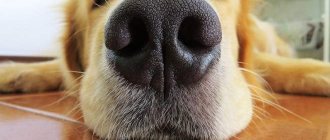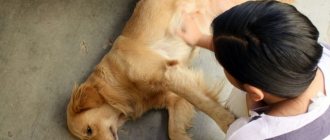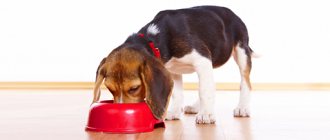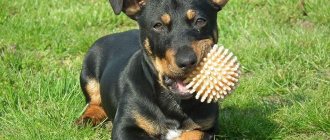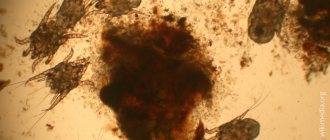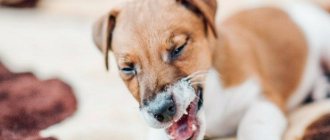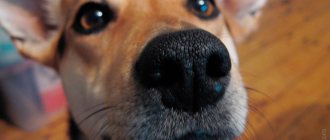There is a common belief among pet lovers that a dog's nose should be cold and wet. If it is hot, then this is a sign of illness.
Dog experts say that this is not so. There are several reasons when a pet's nose is warm, but the animal is not sick.
It is important to understand the reasons for this condition in a dog and learn to distinguish malaise from simple overwork.
Causes
There are conditions when a dog’s nose is not cold, but this is not associated with pathological changes.
The condition can be triggered by the following factors:
- Changes in air temperature and humidity. Walking in hot or frosty weather can lead to changes in the dog's physiological norms. As soon as the animal is at home, in its familiar environment, the nose will again become wet and cold.
Preparation for competitions. Service or show dogs experience significant stress during this time, so their nose may become dry and warm.- Insufficient air humidity in the room during the heating season.
- Change of teeth in puppies.
- Period of sleep or awakening.
- Stress, nervous excitement, fear.
- Allergic reaction.
- Lack of water in the pet’s body (low fluid intake).
- Age: In older dogs, the nasal mucosa gradually changes. In puppies, the process of thermoregulation has not yet been established, so there may be deviations from the norm.
In other cases, the onset of the disease is suspected.
When should you pay special attention to your dog's health?
Unfortunately, quite often a hot nose is observed in a pet during illness. This includes literally all conditions accompanied by fever and dehydration. But, you need to remember that in this case, dry nose is not the only painful symptom. Usually it is accompanied by other, no less striking signs, indicating the nature of the pathology and the severity of the course. The main ones are:
- lack of appetite and sometimes thirst;
- increased thirst;
- excessive lethargy, refusal to play;
- the desire to go into the darkness, to hide from communication;
- aggression, irritation;
- peeling and cracking of the nasal mucosa, rash around the nostrils;
- nasal discharge - thin or thick, greenish;
- lacrimation, photophobia, sneezing, cough;
- rapid breathing and heart rate;
- signs of fever (over 39 degrees);
- dull matted wool;
- constant skin itching;
- hair loss, bald patches.
The dog should be monitored. If these symptoms increase and the dog feels worse and worse, you should immediately take it to the veterinarian.
There is also a group of signs indicating a dog’s critical condition. When they appear, the animal requires urgent help. If your dog has a dry nose and exhibits one or more of the following signs, he may be saved by taking him to a veterinarian immediately:
- rise in body temperature to a level exceeding 40 degrees;
- lethargy, loss of consciousness;
- the presence of seizures or paresis;
- problems of the gastrointestinal tract (vomiting, diarrhea mixed with blood);
- urinating too often or too rarely;
- inappropriate behavior (strong aggression, fear of hydrophobia, walking in circles);
- pain syndrome (moans, whining).
Additional symptoms
If your pet's nose remains dry and hot for more than 3 hours, pay attention to additional signs. They will tell you what kind of disease is developing in the animal’s body.
Snot
A frequent companion of colds or hypothermia. If there is no fever, the animal is given rest, wrapped warmly, and provided with sufficient drinking water.
Rapid breathing
This is a sign of stress. When there is psycho-emotional stress or heavy loads, the animal’s breathing quickens.
The dog breathes frequently if the air temperature rises. As the degrees drop, the pet's breathing becomes uniform.
Lethargy
With almost all diseases, the dog becomes lethargic. It could be a viral infection, a cold, or fatigue. In this case, accompanying symptoms are monitored.
Drooling
This is an alarming symptom that accompanies rabies. In the acute course of the disease, the animal dies within a few days. To prevent this from happening, your four-legged friend must be vaccinated against rabies every year.
Doesn't eat anything
The dog often refuses to eat if there are any health problems. It could be a viral infection or a cold.
If refusal to eat is accompanied by lethargy or increased body temperature for more than a day, contact a veterinary clinic.
Hot paws
This sign indicates an increase in the animal’s body temperature as a whole. If the symptom does not go away within 24 hours, it is accompanied by other signs of infection (lethargy, apathy, refusal to eat) and contact a veterinarian.
Warm nose in hot weather
This sign indicates that the animal is overheating. The dog is taken from the street to a cool room and given a sufficient amount of drinking water. As a rule, after an hour the nose becomes wet and cold.
Therapy
If the animal is seriously ill, treatment is prescribed by a doctor. For acute colds, helminthiasis, and various injuries, therapy is carried out in a clinic under the supervision of a veterinarian. Medicines are also prescribed by a specialist.
In case of heat stroke, stress, or exertion, the animal is given rest and sufficient amounts of drink and food. The room is ventilated and the bedding is changed regularly.
The duration of walks in the heat is reduced, and the dog is not given serious exercise for several days.
For superficial injuries of the nose, the tissues are treated with an antiseptic and a calendula-based ointment is applied. If the wound does not heal for a long time, go to a veterinary hospital.
There is no cure for distemper or rabies. Your pet can be protected from these serious diseases by annual vaccination . Vaccination is the only protection for your four-legged friend against viral infections.
Features of the structure of the nose in dogs
It has long been noted that a dog’s nose should be moist and cool. The moisture in the nose is ensured by the constant secretion of special mucus, which is evenly distributed throughout the animal's nasal mucosa. The main purpose of this lubricant is to form a special filter, invented by nature, with the help of which the dog distinguishes odors much better.
If the nose dries out, the ability to better distinguish odors is lost. In wild living conditions, this can have dire consequences: it did not recognize the prey, did not eat on time, fell ill, or died. Fortunately, most dogs on planet Earth do not face such a fate, since people themselves find food for their younger brothers, completely ensuring their survival.
Science claims that a dog's wet nose increases the ability to distinguish odors several times, to accurately recognize where they came from, and to separate the overall smell into its constituent components. The nose, like the tongue, is a thermostat, one of the organs for maintaining constant balance in the animal’s body.
When not to worry
First you need to decide what kind of nose a healthy dog should have. Normally it is damp and cold. There are reasons when the olfactory organ dries out, but this is not a pathology.
A warm nose in a dog is not a sign of illness when:
the pet walked for a long time in the cold or heat;- he is allergic to household chemicals or plastic dishes (the owner should remove the allergen);
- the dog did not drink for a long time, especially in dry and hot weather;
- My nose got dry while I was sleeping.
If within an hour or two after sleep or a walk the animal's olfactory organ becomes damp and cold again, there is no need to worry. Most likely the pet was overheated or thirsty.
In what cases should you immediately contact the clinic?
Throughout the entire article, we have repeatedly emphasized that you will still have to call a veterinarian to see your pet. But here are the cases in which you need to immediately contact the clinic:
- If the pet lies flat and does not react to anything at all.
- Refusal of water. A short-term (up to 12 hours) hunger strike is allowed, since it is not so dangerous for the puppy’s life.
- Apathy, strange behavior of the animal. These signs may indicate serious infections and central nervous system damage.
- Hoarse, heavy and intermittent breathing. This is how severe upper respiratory tract diseases manifest themselves.
Good to know
- Rapid breathing in dogs. What to do if you have increased breathing? What types of breathing problems do dogs have?
- Why does my dog often vomit yellow or white foam? Treatment for vomiting in dogs
- Why doesn't the dog eat anything? Causes, aspects of diagnosis, treatment and prevention. What to do if your dog won't eat food or food?
- Why does a dog scratch its ears and shake its head (reasons, range of diseases, diagnosis, treatment and prevention). Why does my dog constantly shake his ears?
- What is the reason why a dog constantly whines? How to solve this problem? When should you contact a veterinarian?
- Why is my dog breathing heavily and frequently? First aid for a dog with difficulty breathing
- Why does a dog eat cat feces? The problem is serious and urgent. Find out how to correct this bad habit
- Why does a dog drink a lot of water? The main causes of thirst in dogs and tactics for animal owners. What should you do if your older dog starts drinking a lot of water?
- Eye Discharge in Dogs - Why do my dog's eyes water or have discharge?
- Why does a young dog have bad breath? Have you considered the main causes of unpleasant mouth odor in dogs? An elderly dog has bad breath, what should I do?
- Why can a dog lose hair in patches or all over its body? What is the reason? What to do? How to treat hair problems in dogs?
- Why does my dog have diarrhea? Dog diarrhea (causes, pathogenesis, diagnosis, signs and symptoms, first aid, treatment and prevention)
- How to treat bartonellosis in dogs? Bartonella is a causative agent of septic processes in animals and humans. How to make a correct diagnosis?
- Canine bordetelosis (epizootology, distribution, pathogenesis, symptoms and signs, treatment and prevention). Bordetella in dogs (Bordetella bronchiseptica)
- How to treat adenovirus in dogs? How to make a correct diagnosis? Symptoms, treatment, prevention and vaccination for adenovirus infection in dogs
- Why is the dog lethargic and constantly lying down? Oppression of dogs. When should you seek veterinary help?
Home care and when to call the vet
If your dog has a temperature above 39, you should call your veterinarian. Fever above 40 is an emergency that must be addressed promptly.
If your dog has a temperature above 100 degrees Fahrenheit, you can lower his body temperature by running cool water on his fur, especially around the ears and paws.
Using a fan on damp wool will help reduce the temperature. When doing this, be sure to monitor your dog's rectal temperature and stop the cooling procedure when it reaches 39.5. You should not lower the temperature too quickly.
If your dog has a fever, try to make sure he drinks enough water regularly to stay hydrated, but don't force it. And never give your dog medications meant to reduce fever, such as acetaminophen or ibuprofen, as these can be poisonous to dogs and cause serious stomach, liver and kidney damage or death.
^Top
When you need to urgently take a patient to a veterinary clinic
The only accurate way to determine if your dog has a fever is to take his rectal temperature.
Experts recommend using a digital thermometer specifically designed for rectal use in dogs. Most thermometers designed for use in the human ear are not suitable for this purpose.
To take your dog's temperature, first coat the thermometer with a lubricant such as petroleum gel or baby oil. Then carefully insert the thermometer one to two centimeters into your dog's anus and wait for the results. Most thermometers will take less than 60 seconds to register for this purpose. You can also use a mercury thermometer, but you need to measure for at least 5 minutes.
Allergy in an animal
Allergies can be triggered by flowering plants, as well as woolen items, food, and household chemicals. It is quite difficult to independently determine the source of an allergy.
During a food reaction, you may experience:
- itching of the skin;
- inflammation of the ears;
- disruption of the stomach and intestines;
- lacrimation.
Skin allergies may occur when exposed to aggressive substances. As a result, there is itching and redness on the skin, which does not go away even after using antibacterial drugs.
Infection with worms
Helminths can cause intoxication in the dog’s body. In this case, in addition to dry nose, other symptoms are observed, in particular:
- unstable stool;
- vomit;
- difficulty swallowing food;
- itching in the anal area.
The dog will be very lethargic, as worms weaken the animal’s body. Therefore, for prevention, it is recommended to periodically take anthelmintic drugs. If you have such symptoms, it is advisable to get tested and, if necessary, carry out anthelmintic therapy.
